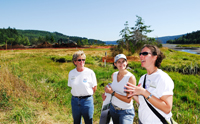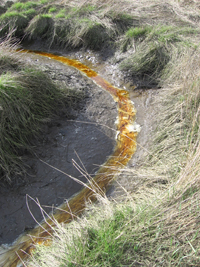Salmon Creek Estuary Restored
NOAA's restoration of the Salmon Creek Estuary, found at the head of Discovery Bay near Port Townsend, Wash., is one of the most important restoration projects in the greater Puget Sound area.
Once home to Endangered Species Act threatened chum salmon, as well as Chinook and steelhead salmon, much of this estuary has been uninhabitable for fish due to wood waste runoff from a lumber mill that operated in the 1950s.
Sulfur and ammonia leaches from wood waste into the water, making it difficult for salmon and a number of other important species to live in the estuary.
"Unfortunately, much of the Puget Sound is threatened by similar problems along the coastline," said Polly Hicks of the NOAA Restoration Center. "There are hundreds of estuaries just like Salmon Creek that are partially filled and degraded by waste from old lumber mills, making it difficult to sustain salmon populations."
A Productive Partnership
For more than four years, NOAA's Restoration Center has been working with the North Olympic Salmon Coalition, the FishAmerica Foundation, and the Washington Department of Fish and Wildlife to research, fund, and implement the restoration. Work began in late July on the 11-acre site. When finished, more than 22,000 cubic yards of wood waste, 38,000 cubic yards of gravel, and five derelict lumber mill buildings will have been removed to restore 2,600 feet of tidal channel and salt marsh.

Staff from the North Olympic Salmon Coalition and NOAA speak with volunteers about the restoration as backhoes excavate a 30-foot pile of wood waste.
High resolution (Credit: NOAA)
Although the main purpose of the project is to restore estuarine habitat for salmon, other wildlife, including shorebirds, waterfowl, fish and shellfish, also will benefit from the Salmon Creek Estuary restoration. Bald and Golden eagles will once again feed on salmon along the creeks and intertidal areas, and Roosevelt elk will graze on the grasses nearby.
The Salmon Creek Estuary will soon be a much healthier place for people too. Members of the Port Townsend area community are helping with monitoring so that they may see the project unfold, witness the before and after, and be part of the outcome. In addition, the wood waste will go mostly to a local farm for reuse as winter bedding and compost since the wood was not treated by the lumber mill during manufacturing.








